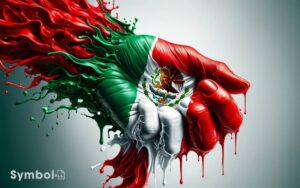What Does the Color White Symbolize in the Bible? Explained!
In the Bible, you’ll find the color white deeply signifies purity, righteousness, and divine presence. It’s a visual marker of sanctity, serving as a cue for divine favor and moral impeccability.
Through heavenly visions, white embodies an unblemished state, representing sanctification and a clear separation from sin.
This color’s significance extends to angels donning white robes, symbolizing celestial purity that’s beyond human grasp. It highlights divine revelations and the profound presence of God, marking divine intersections with the earthly domain.
As you explore this symbolism further, you’ll uncover layers of meaning associated with white, revealing the depth of its biblical importance.

Key Takeaway
Purity and Sinlessness
In the biblical narrative, white often symbolizes purity and sinlessness, reflecting a state of spiritual perfection and divine approval.
This association isn’t merely incidental but deeply ingrained in the text’s fabric, serving as a visual cue to the reader about divine favor and moral impeccability.
Consider how the High Priest’s garments, described in Exodus, are to be of white linen, symbolizing righteousness and serving as a prerequisite for entering the Holy of Holies.
This color’s choice isn’t arbitrary but meticulously selected to convey sanctity and separation from sin.
In your journey through the scriptures, you’ll find that this symbolism extends beyond attire to scenes of heavenly visions, where white represents an unblemished state that humans aspire to through divine grace, underscoring a narrative of redemption and sanctification.
Divine Manifestation
As you reflect on the biblical depiction of divine manifestation, consider how white serves as a central symbol in illustrating God’s presence, signaling not only purity but a profound revelation.
The imagery of angels’ robes, described as white, further cements this color’s role in denoting a heavenly purity that transcends human understanding.
This connection invites you to ponder the multifaceted ways in which white encapsulates both the visibility and mystery of the divine.
Gods Presence Revealed
Throughout the Bible, the color white frequently symbolizes God’s divine presence, offering believers a tangible sign of His omnipresence and guidance.
This symbolism serves as a visual cue to the faithful, marking moments where the divine intersects with the earthly domain.
When you encounter white in biblical narratives, it’s often a signal that God’s presence is manifest, whether through angelic visitations, the garments of the high priest, or the transfiguration of Jesus. Each instance isn’t merely a detail but a profound revelation.
It’s as if the scripture uses white to highlight scenes where heaven touches earth, reminding you of the sacredness that pervades our existence.
White becomes a beacon, guiding believers towards a deeper understanding of God’s nearness and sovereignty.
Heavenly Purity Symbolized
Beyond merely representing God’s presence, the color white in the Bible embodies divine purity, offering a lens through which to view the unblemished and holy nature of the divine domain.
You’re invited to reflect on how this celestial whiteness isn’t just aesthetic; it’s deeply symbolic, resonating with themes of sanctity, redemption, and divine clarity.
This purity isn’t simply about moral impeccability but also signifies the profound transformation available to believers, encapsulating hope and renewal.
| Aspect | Significance | Biblical Connection |
|---|---|---|
| Purity | Holiness, without blemish | Revelation 19:8 |
| Transformation | Renewal, becoming new | Isaiah 1:18 |
| Clarity | Divine truth, unclouded vision | Psalm 51:7 |
Reflecting on these elements enriches your understanding of divine purity, encouraging a deeper contemplation of the spiritual journey.
Angels Robes Described
In the biblical narrative, angels’ robes often serve as divine manifestations, embodying purity and the sacred, which further illuminates their role as messengers of God.
These robes aren’t just attire; they’re potent symbols that convey messages beyond the scope of verbal communication.
Let’s explore further:
- Immaculate Whiteness: Symbolizing unblemished purity and divine wisdom, the white robes stand as a proof to the angels’ celestial nature and their closeness to the divine.
- Ethereal Glow: This aspect emphasizes the heavenly origin and the supernatural aspect of angels, setting them apart from earthly beings.
- Symbol of Authority: Their garb marks them as bearers of God’s word, highlighting their authority in delivering divine messages.
Through these elements, angelic robes in the Bible encapsulate the essence of divine manifestation, bridging the celestial and the terrestrial.
Angelic Appearances
As you explore the symbolism of the color white in the Bible, it’s important to contemplate the depiction of angels in white robes.
These divine encounters, often described with angels garbed in luminous white, provide profound insight into the purity and holiness they represent.
Reflecting on the symbolism of angelic white invites a deeper understanding of its significance in biblical narratives.
Angels in White Robes
Throughout biblical narratives, angels adorned in white robes frequently symbolize purity, divine intervention, and messages from the divine domain.
This imagery isn’t merely decorative; it’s laden with profound symbolism that beckons a deeper understanding.
Here’s what the presence of these celestial beings in white robes signifies:
- Purity and Holiness: The white robes mirror an unblemished righteousness, reflecting an inherent purity that’s synonymous with the divine domain.
- Divine Intervention: Their appearances often herald significant interventions or guidance, marking moments where the divine will intersects with human affairs.
- Messages from the Divine: Angels in white are messengers, bearing revelations or instructions that pivot the course of events or enlighten individuals on divine will.
In contemplating these aspects, you’re invited into a reflective journey on the nature of divine communication and the embodiment of purity.
Divine Encounters Described
The Bible’s narratives frequently depict divine encounters through angelic appearances, offering profound insights into the nature of these celestial visitations.
These encounters often serve as pivotal moments, heralding significant events or delivering messages of great importance.
You’ll notice that these narratives aren’t just arbitrary; they’re meticulously constructed to convey theological truths and spiritual realities.
Through these divine visitations, you’re invited to explore the multifaceted ways in which the divine interacts with humanity.
Whether it’s guiding, warning, or delivering a message, each encounter underscores the angels’ roles as messengers and servants of God.
Reflecting on these stories, you gain a deeper appreciation for the complex relationship between the divine and the earthly, marked by moments of profound revelation and transformation.
Symbolism of Angelic White
Building on our understanding of divine encounters, we now explore the symbolism of angelic white, a color deeply intertwined with these celestial visitations.
In biblical narratives, white often emerges as a symbol of purity, divinity, and the supernatural domain.
This color’s association with angels isn’t merely aesthetic but laden with profound theological significance.
- Purity and Holiness: White signifies the unblemished nature of angels, serving as God’s messengers.
- Divine Revelation: The appearance of angels in white heralds divine truth and guidance, illuminating the path for those they visit.
- Transcendence and Hope: The radiant white of angelic beings symbolizes a connection to the divine, offering hope and reassurance of God’s presence.
In reflecting upon these aspects, you’re invited to contemplate the multifaceted symbolism of white in angelic appearances, enriching your understanding of biblical narratives.
Victory and Triumph
In examining the symbolic use of white within biblical narratives, one finds that it frequently represents victory and triumph, underscoring the profound spiritual victories in the lives of believers.
This color’s presence isn’t merely decorative; it weaves a deeper narrative of overcoming, often against insurmountable odds.
When white appears, it’s a signal, a beacon of divine favor and the eventual triumph of good over evil.
This motif resonates through the stories of biblical heroes and the ultimate victory promised to the faithful.
It’s a reminder that in the biblical worldview, victory isn’t always about earthly triumphs but about spiritual conquests.
The color white, then, is emblematic of the ultimate victory that awaits those who persevere in their faith.
Righteousness of Believers
Shifting our focus to the symbolism of white as it pertains to the righteousness of believers, we observe that this color encapsulates the purity and moral integrity that characterizes those walking in faith. This connection underscores the transformative power of faith, as the color white spiritual symbolism meaning often conveys a state of being cleansed and sanctified. It serves as a visual reminder of the divine grace that enables believers to strive toward holiness and live in alignment with spiritual principles. In many traditions, white garments or light are used to represent this elevated state of purity and connection to the divine.
In the biblical context, white serves not just as a color but as a profound emblem of the sanctification and redemption believers experience through their faith.
To paint a clearer picture:
- White Garments: Symbolizing the believers’ cleansed and renewed nature, free from sin.
- Light: Reflecting the enlightenment and guidance in the path of righteousness.
- Unblemished Lamb: Representing the ultimate sacrifice for sin, highlighting the purity and innocence required for atonement.
These elements collectively illustrate how white transcends mere color, embodying the spiritual purity and moral righteousness that define the believer’s journey in faith.
The Transfiguration
As you consider the Transfiguration, reflect on its portrayal of symbolic purity and divine glory.
The vivid imagery of white in this event underscores its significance as a moment of spiritual revelation and purity.
This scene encapsulates the manifestation of divine glory, offering profound insights into the theological and symbolic dimensions of color in biblical narratives.
Symbolic Purity Representation
Delving into the Transfiguration, you’ll find white symbolizes a profound purity, highlighted through Christ’s radiant transformation.
This event isn’t just a miraculous moment; it’s a vivid portrayal of purity that transcends human understanding.
Consider these elements:
- The Radiance of Christ’s Garments: Described as whiter than any earthly bleach could achieve, this supernatural whiteness signifies an unblemished purity, untouched by worldly corruption.
- The Setting on the Mountain: Mountains in biblical narratives often symbolize a closer proximity to God and a separation from worldly concerns, reinforcing the theme of purity.
- The Presence of Moses and Elijah: Symbolizing the Law and the Prophets, their presence with Jesus in this moment unites the past, present, and future in a pure, divine purpose.
Through these elements, the symbolism of white as purity is deeply intertwined with the narrative, inviting reflection on the nature of purity itself.
Divine Glory Manifestation
In the narrative of the Transfiguration, divine glory is not merely observed but experienced, revealing the profound intersection of the divine and the human through the lens of white’s symbolic purity.
You’re invited to reflect on the significance of white within this scenario, where it serves as a medium of divine revelation.
| Aspect | Significance |
|---|---|
| White Light | Represents divine presence, purity, and holiness. |
| Transfiguration | A moment of revelation and divine glory. |
| Garments | Symbolize righteousness and redemption. |
This moment emphasizes the transformative power of divine presence, encapsulated in the whiteness that envelops Jesus.
You’re witnessing a symbol of hope, purity, and the ultimate manifestation of divinity, pointing towards the eternal and the sacred.
Garments of Salvation
Exploring the biblical narrative, one finds that the color white, particularly in the context of garments, symbolizes purity and redemption, serving as a metaphor for the transformative power of divine salvation.
This symbolism is profound, weaving through the text to convey messages of hope, renewal, and divine love.
To understand this concept, consider:
- Purity: White garments represent a cleansing from sin, a return to a state of innocence before God.
- Redemption: They symbolize the believer’s redemption through divine intervention, marking a shift from a state of spiritual bondage to freedom.
- Transformation: This imagery reflects the believer’s spiritual metamorphosis, from a life marred by sin to one of righteousness and holiness, clothed in the salvation offered by the divine.
The Heavenly Throne
The depiction of the Heavenly Throne in biblical scripture offers a profound insight into the divine domain, embodying themes of judgment, sovereignty, and majesty.
Through this imagery, you’re invited to contemplate the ultimate authority of the divine, marked by purity and righteousness.
The color white, often associated with this celestial setting, signifies not only purity but also the transcendent perfection of God. It’s a visual representation that serves to underscore the holiness and unblemished nature of the divine sphere.
This symbolism encourages a reflection on your own spiritual journey, urging you towards a state of purity in your thoughts and actions.
As you dive deeper into the text, the white surrounding the Heavenly Throne becomes a beacon, guiding you towards an understanding of divine perfection and the pursuit of holiness in your life.
End Times Prophecy
Reflecting on the Heavenly Throne’s symbolism, let’s now turn our attention to how the Bible depicts End Times Prophecy, a topic that continues to intrigue and inspire deep theological discussion.
Considering this, the color white plays a significant role, underscoring themes of purity, victory, and divine judgment.
- Purity: White symbolizes the ultimate purity of those who’ve been redeemed and are presented without blemish before God.
- Victory: It signifies the triumph of God’s kingdom over evil, where white robes are often granted to those who’ve overcome through faith.
- Divine Judgment: White also illustrates the righteous judgment of God, separating the pure from the impure, as depicted in the final battle between good and evil.
These elements together paint a vivid picture of the hope and solemnity that envelops the biblical narrative of the End Times.
The New Jerusalem
In biblical discourse, the New Jerusalem stands as a paramount symbol of God’s promise, embodying eternal peace and divine perfection.
You’ll find it represents not just a physical location but a spiritual zenith where purity and holiness are paramount.
The color white, often associated with this celestial city, underscores its inherent purity and the unblemished nature of what it stands for.
Delving deeper, you’ll see it’s not merely about the absence of sin but the presence of a divine order.
The New Jerusalem, as a result, serves as a beacon of hope, illustrating a future where God’s light outshines the darkness of the past. It’s a reflection of ultimate redemption, where the faithful are promised a place devoid of sorrow, bathed in the everlasting light of God.
Conclusion
To sum up, the color white in the Bible signifies an intricate tapestry of purity, divine presence, and ultimate victory. It’s not just a color but a symbol of the profound journey from sinlessness to glorification.
Imagine a world where every believer’s garment shines white, reflecting their inner righteousness and salvation.
This imagery isn’t just poetic; it’s a reflective call to purity and a reminder of the divine promise of victory and eternal peace in the New Jerusalem.






